By Michael Mozdy
Sharing resources is a necessary part of doing scientific research. Researchers don’t have unlimited budgets – in fact, they’re competing aggressively for every dollar they can get. So, when a new, game-changing but expensive technology emerges, researchers need to be resourceful about how they can get to use it without buying it wholesale.
For example, take DNA research 30 years ago. Scientists needed to create short sequences of DNA, called oligos, to use in experiments. New DNA synthesizers became commercially available, but who wanted to buy this expensive piece of equipment for a few experiments? Could anyone really use this equipment enough to make it worthwhile? Jerry Kaplan, PhD, a cell biology researcher and faculty member of the Pathology Department, decided to purchase a machine and set up a DNA peptide service that other researchers could use. He set it up to they could define exactly what type of oligo they needed and pay him back for the service. This way, the cost of the machine was spread among many researchers, and not everyone had to buy a new machine.

Mike Hanson, PhD (left), and John Phillips, PhD, stand next to a framed reproduction of the cover of the September 2016 Journal of the American Chemical Society displaying their paper, made possible thanks to the work of the DNA/Peptide Synthesis Core.
This win-win scenario was the first of what we now call “Core” facilities here at the University of Utah. As the number of cores grew, it became apparent that there were administrative tasks like billing, reporting, and marketing their services that could be centralized to help researchers focus on their research.
Today, there are over 50 cores and recharge centers spread across main campus and the health sciences campus. The man in charge of administering the health sciences cores is John Phillips, PhD, and – a researcher himself – he is keenly aware of the need for efficiency, quality services, and bang-for-the-buck.
From Heme to Team
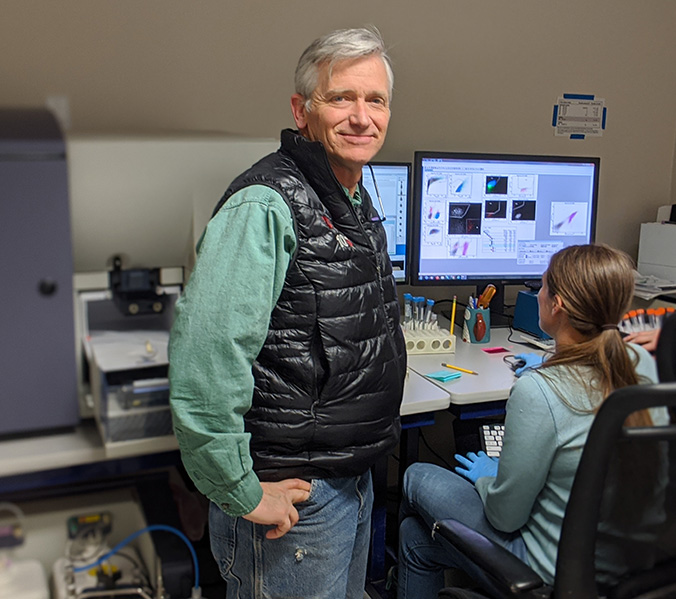 |
| John Phillips, PhD, visits the Flow Cytometry Core. |
Phillips comes from the Northeast, where he received a BS in animal science from the University of New Hampshire. Next, he worked as a lab tech in an immunology lab while moonlighting at a Vermont brewery as Director of Quality Control. The heady beer business was no match for his love of science, though, and he graduated with a PhD in Biochemistry from Dartmouth Medical School. As chance would have it, he and his wife, who received her MD at the same school, decided to move to Salt Lake City for their postdoctoral and residency work. They never left.
Phillips quickly developed an interest in how iron is stored in mammalian cells, specifically thanks to the heme molecule, which it turns out is essential for life on earth. Within three years, Phillips became an assistant professor in the School of Medicine’s Hematology/Oncology Division. He has devoted his research career to understanding how heme is synthesized in cells and how disruptions in this pathway creates rare diseases like Porphyria Cutanea Tarda. He has been continuously funded by the NIH since the early 1990s, and has increased his commitment not only to the national Rare Disease Clinical Research Network, but also to University of Utah Health Sciences.
Despite his down-to-earth, just-a-guy-in-the-next-lab attitude, Phillips boasts a staggering number of administrative appointments, including: as Director of the Health Sciences Core Facilities, Director of the Cell Therapy and Regenerative Medicine Program, Principal Investigator of the Utah site for the Rare Diseases Clinical Research Network’s Porphyrias Consortium, Chair of the Internal Medicine Research RPT Committee, Institutional Review Board committee member, VPCAT mentor, CCTS Internal Advisory Committee member, and Assistant Dean for Research and Infrastructure.
Although leadership of the 29 Health Sciences cores and recharge centers is just one of his many hats, Phillips approaches the job with strategy and precision.
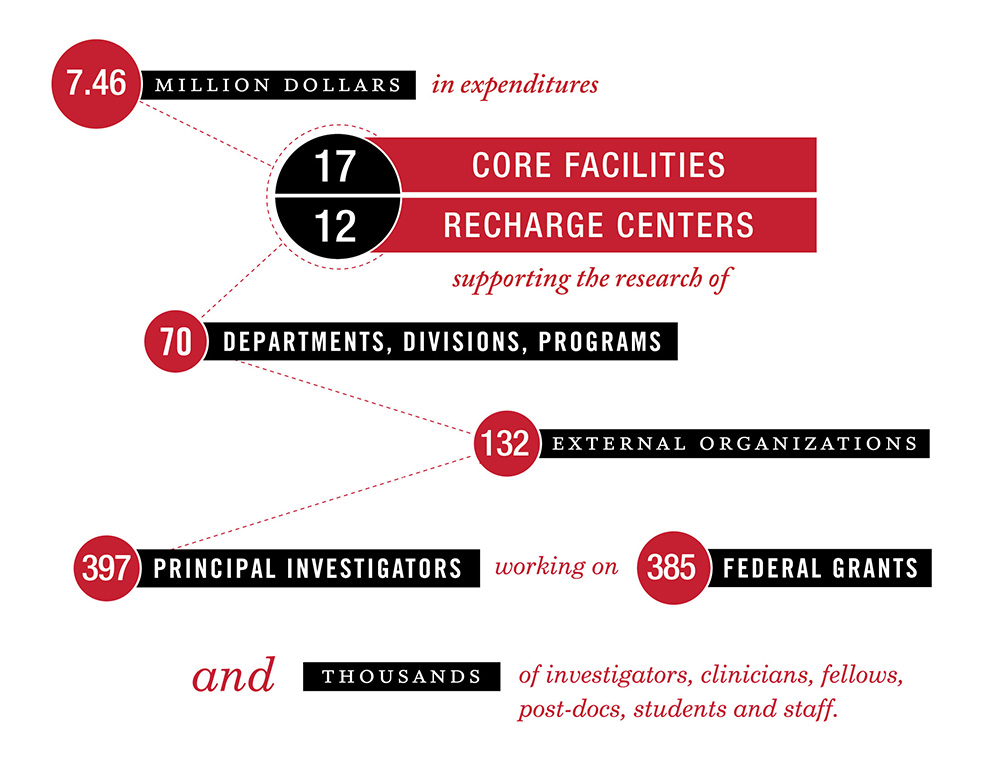
Tools of the Trade
|
A Research Core: An independently managed center for service and/or technology that serves as an open, first-come-first-served resource for researchers across the University. Cores charge researchers for their services. |
|
A Recharge Center: Much like a core, these centers charge for their services and are open to all researchers. They operate more on a “fit you in when we can” model and have a variety of management structures (department, interdisciplinary group, etc.). All Recharge Centers – like cores – have scientific directors and oversight committees. |
A recharge center does not need to use the administrative tools provided by the official Health Sciences Cores administration team, but if they do, Phillips has made sure they’re getting real value. “It’s about efficiency for the system, but also access to great equipment and expertise, not to mention cost savings, for the researcher,” states Phillips. Much of this value comes from custom IT solutions: online forms to help users of the center, reports for the managers of the center, and automatic billing to University labs and groups so that invoicing has become obsolete.
The Cores web site is itself a great tool for educating researchers about the vast array of tech and services available to them. From genomics to biostatistics, nuclear engineering to metal fabrication, scientists at the University of Utah have a huge set of resources that puts them steps ahead of researchers at other organizations. “As science becomes more complex, sometimes it’s easier to outsource some of the technical work to experts who do it constantly,” Phillips asserts. “The core people are geeks in what they do, in the best sense of that word. They want to do what they’re doing and why not use the expert?”
Once a researcher chooses a recharge center, the web site provides details on the options and pricing for the services. For instance, for Flow Cytometry, you’ll see 3 cell sorters, 4 analyzers and an analysis workstation to choose from, each providing specifications, cost and the ability to make an appointment with the equipment right then and there. Other cores provide even more functionality on the web site, such as ordering specific DNA or peptide sequences to be built, where the researcher can input the exact sequence on the web form.
“Each core or recharge center can decide how much workflow or scheduling they want to integrate,” notes Phillips. “We provide the front end and back end – from web content to scheduling and billing.”
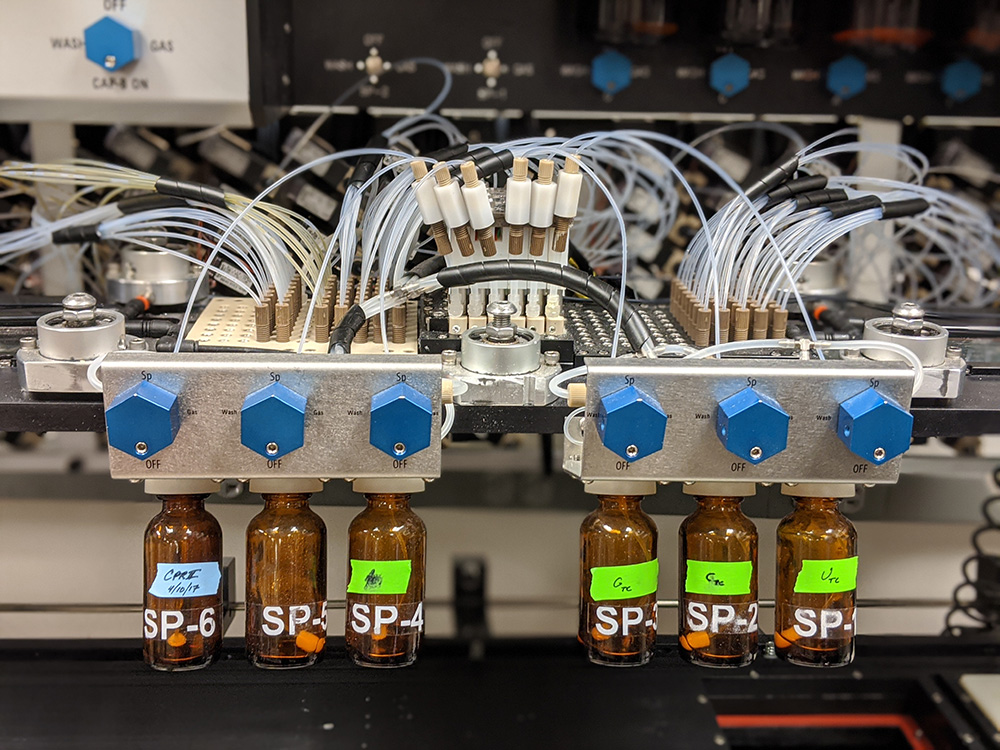
Detail of DNA synthesizer in the DNA/Peptide Synthesis Core.
Proactive Work in the Health Sciences
Phillips works with an oversight committee to review the work and finances of the Health Sciences Cores. His team produces an annual report that details everything down to the penny and the minute; full transparency is not only expected, it’s built into the tools they use.
This oversight committee also works with Phillips to plan for new needs. He keeps his finger on the pulse of researchers’ technology needs through constant conversation and an annual survey. “Let’s say 10 people want a viral production core, which we don’t have,” he illustrates. “We can look at hiring somebody, finding space, training, buying equipment, etc., or we can see if we can put that service in another core.” Phillips and Health Sciences leadership are very flexible with how new technology is procured and set up. He notes that the primary funder may be the researcher, the department, the college, or the VP for Research, Andy Weyrich, PhD. Each center that is set up, whether a core or a recharge center, is configured in a way that meets the particular needs and scenario.
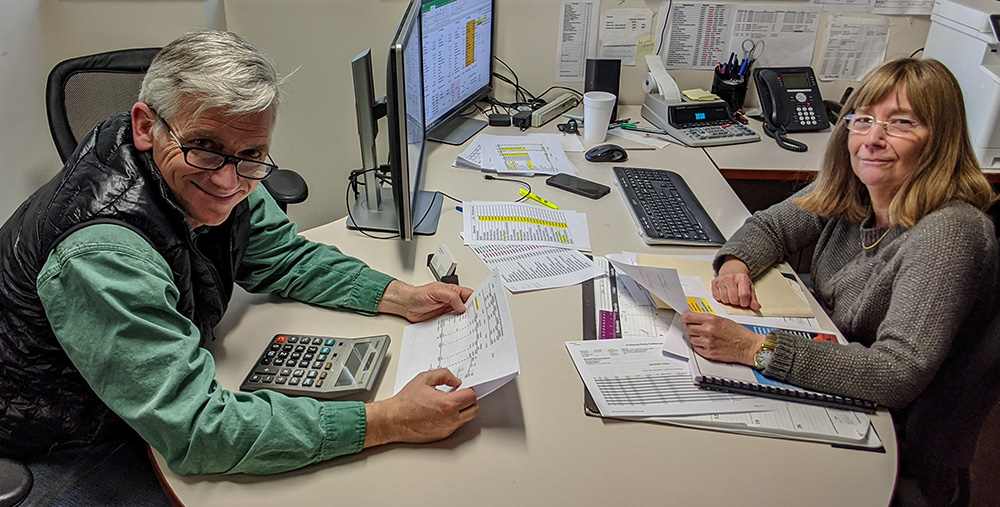
Much of Phillips' work involves keeping a close eye on budgets, which he does here with his Associate Director of Accounting and Finance, Brenda Smith.
A separate project that excites Phillips is the in-house-built inventory tracking system that joins RFID tags and a powerful relational database. This much-needed tool helps everyone know where all the “stuff” is: computers, materials, freezers, centrifuges, laptops, and much more. “You simply scan the RFID tag on the equipment it pulls up the record: the purchase cost, description of what it is, specs, owner, picture, it’s location,” Phillips says. The inventory system currently tracks 5,540 assets worth $91M in 1,016 locations, across 82 campus entities.
The MRI Recharge Center
 |
| Ed DiBella, PhD, Scientific Director of the MRI Recharge Center |
 |
| Henry Buswell, MRI Research Manager |
Unknown to some people, the Department of Radiology and Imaging Sciences operates an MRI Recharge Center in the Imaging and Neurosciences Center (INC) building. The Center manages time for researchers on six 3-Tesla and several 1.5-Tesla MRI scanners and also provides customized MRI sequences and receiver coils that are beyond the standard of care. Our dedicated MRI equipment is unparalleled in the Intermountain region for the handling of the most difficult and unique research projects.
While we do not use Phillips’ administrative tools because we must bill patient insurance for studies (the Health Sciences Cores do not interact with patient care systems), our team works closely with him in other areas. Ed DiBella, the scientific director of the MRI Recharge Center and Director of the Utah Center for Advanced Imaging Research (UCAIR), sits on the oversight committee for the Preclinical Imaging Core Facility along with Phillips.
“John makes it look easy,” says DiBella, “but we know it’s not. He’s got a huge amount of responsibility and he handles it gracefully and well.”
DiBella works closely with Administrative Director Amy Sikalis, MRI Research Manager Henry Buswell, and Financial Administrator Carla Ortiz to make sure that the MRI Recharge Center operates efficiently. In fiscal year 2019, our top three MRI scanners saw 3,178 billable hours of use. That’s over 12 hours per working day, and Buswell explains that this number isn’t actual time spent by staff with the MRI machines. “When you factor in building protocols, quality control, training of research staff, and other activities we do, you should add a half an hour for each hour of billable time,” he says. That means our MRI Recharge Center accounts for about 4,800 hours’ worth of work, helping 24 principal investigators across 5 different departments.
Thanks to the hands-on efforts of the management team, we ensure the lowest possible costs for University users of the MRI Recharge Center. Our annual financial report attests to this fact.
Geared for the Future
If the growth in the number of cores and recharge centers is any indication of the health of the research enterprise, the University of Utah is doing quite well. But it’s not just the number of centers that counts; it’s the way they’re managed. Thanks to the work of Phillips and other research leaders overseeing the centers, this is going very well, too. “I used to think that cores were a static thing,” admits Phillips, “that revenue would be sort-of flat. But if you look at revenue from the cores, it continues to increase”
The story of our research cores is another example of how we are geared not just to make one or two hotshot researchers great, but to bring up the quality of work across the University. Every researcher is given the technology and tools they need – it is not hoarded in one or two areas like it is at some other top research schools. Despite shrinking federal funding and increasing competition for funds, it’s a good day to be a researcher in Utah.
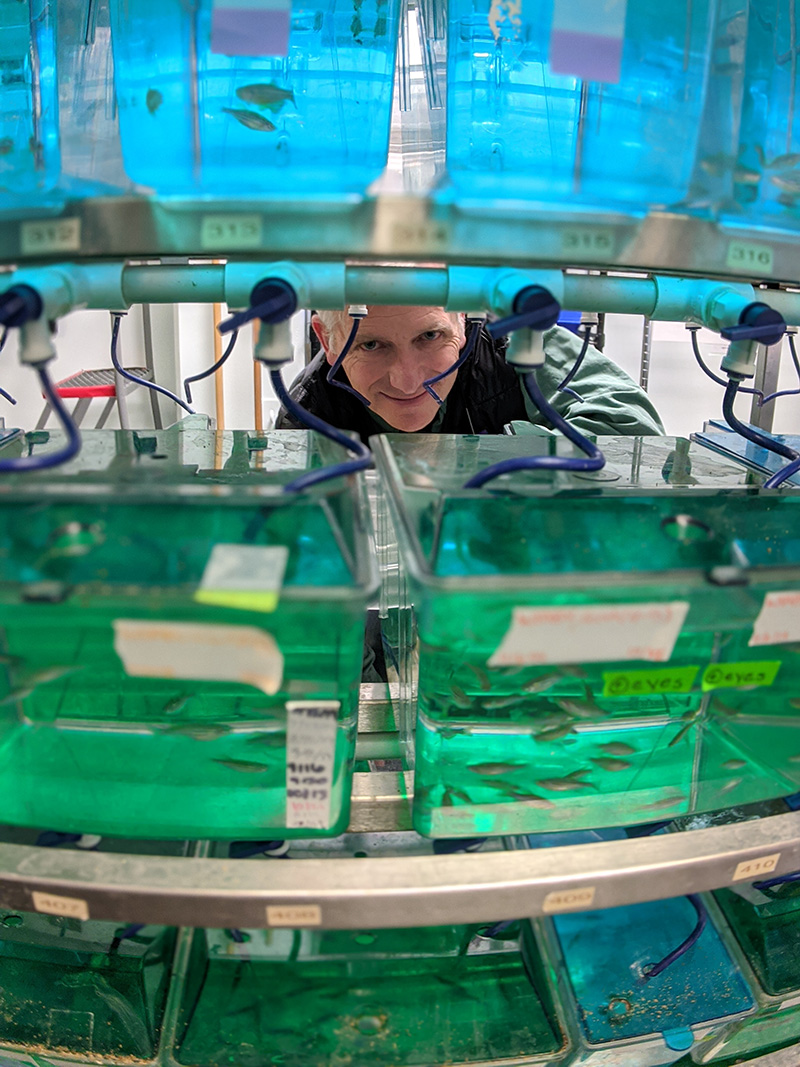
Phillips is proud of the Zebrafish Core, the largest of its kind west of the Mississippi, with 8,000 tanks, specialized brine shrimp production for food, and many specially-trained staff who manage the needs of researchers and fish alike.